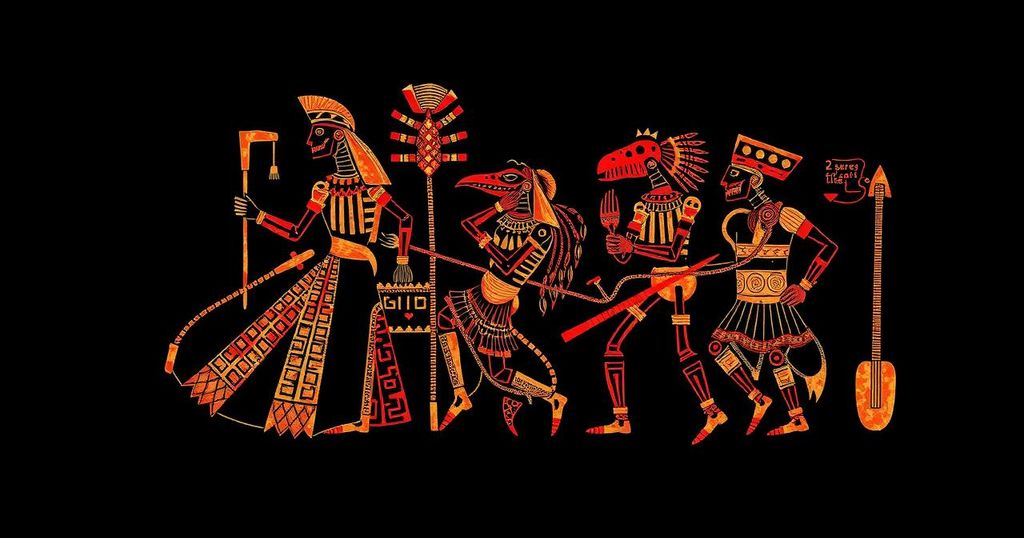Using artificial intelligence, researchers have identified hundreds of ancient Nazca geoglyphs in the Peruvian desert, including depictions of human sacrifice and domesticated llamas. These smaller, older figures are distinct from the larger Nazca lines. The AI significantly expedited the identification process, with a total of 303 geoglyphs discovered during recent field surveys. The findings provide a glimpse into the ritualistic elements of Nazca culture while highlighting the importance of protecting these archaeological sites from modern threats.
Recent advancements in artificial intelligence have led to the discovery of hundreds of ancient geoglyphs in the Peruvian desert, including depictions of decapitated human heads and domesticated llamas. These figures are attributed to the Nazca culture, which began creating such images, known as geoglyphs, approximately 2000 years ago. Unlike the more well-known Nazca lines that consist of massive geometric shapes and animals, the newly unearthed geoglyphs are smaller and older, generally measuring around 9 meters in length and typically featuring humanoid figures and domesticated animals. Some of these images suggest themes of human sacrifice, reflecting similar motifs found on Nazca period pottery, such as orcas wielding knives that are depicted severing human heads. The identification of these geoglyphs was made possible through the use of a specially trained AI model, which analyzed high-resolution aerial photographs of the Nazca Pampa, an area significantly larger than Manhattan. The model generated a grid mapping system that indicated the likelihood of various locations containing geoglyphs. Although researchers still conducted extensive manual inspections—totaling over 2600 hours—the AI was instrumental in expediting the review process, significantly reducing the imagery that required human examination and focusing efforts on promising candidate areas. As a result, a total of 303 figurative geoglyphs were identified during field surveys in 2022 and 2023, with 178 figures recognized directly by the AI and an additional 66 located within clusters highlighted by the technology. Experts express optimism regarding the use of AI in archaeology, emphasizing its potential to create a comprehensive map of the geoglyphs in the Nazca region, a feat that remains unachieved. However, they caution that the technology is likely to identify mainly the more visible geoglyphs, leaving the less obvious figures potentially undiscovered. Currently, nearly 1000 other AI-identified geoglyph candidates await further field inspections, with many of the newly found smaller geoglyphs believed to be associated with individual or group rituals. In contrast, the more substantial Nazca lines are interpreted to have served broader ceremonial purposes. The insights gained from this AI-driven approach may extend beyond the current World Heritage Site of the Nazca lines, as the rapid identification of geoglyphs could protect them from threats posed by agricultural expansion and urban development. The urgency of this research is emphasized by the potential loss of archaeological sites due to advancements in these areas.
The Nazca culture, which flourished in ancient Peru, is renowned for its remarkable geoglyphs, large designs carved into the ground that include various symbols, animals, and geometric shapes. These artworks have sparked significant interest among researchers and archaeologists, primarily due to their historical and cultural significance. The introduction of AI technologies for analyzing aerial imagery marks a considerable advancement in the discovery and preservation of these cultural artifacts. The recent findings will contribute to a more nuanced understanding of Nazca rituals and practices, helping to contextualize the role of smaller, less visible geoglyphs within the broader archaeological narrative of the region.
In conclusion, the integration of artificial intelligence into archaeological efforts has yielded significant discoveries of ancient Nazca geoglyphs, revealing insights into the culture’s practices and beliefs. While the use of AI dramatically enhances the efficiency of identifying potential geoglyphs, it also highlights the need for continued archaeological exploration to uncover lesser-known figures. The urgency of this work is underscored by ongoing threats to such sites, necessitating a proactive approach to preservation.
Original Source: www.newscientist.com







